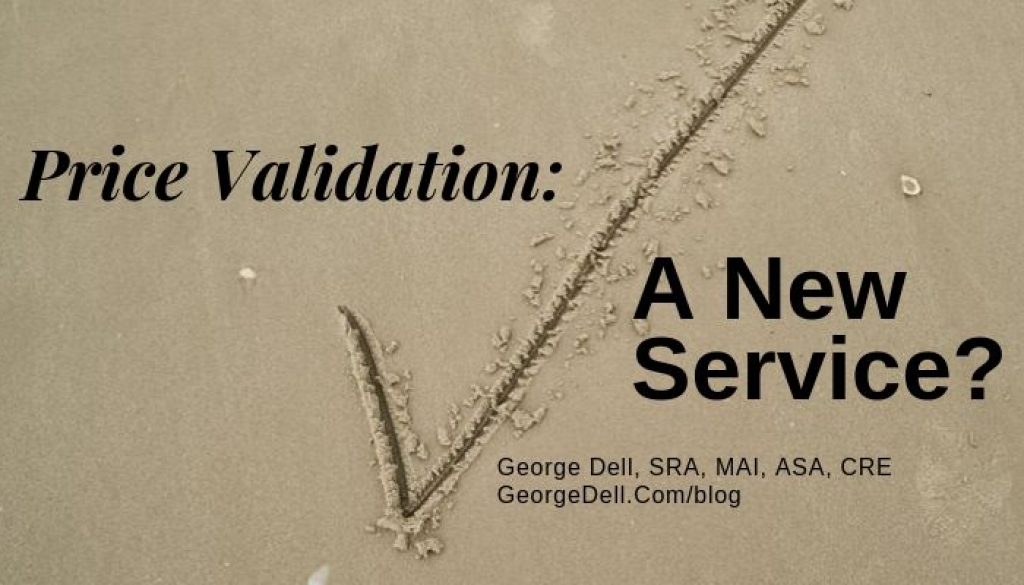How does price validation differ from your traditional appraisal opinion?
One of the arguments against the value of appraisals is that appraisers almost always just land on the sale price. How does this happen? Why?
There are some obvious answers.
- The market system works, so the sale price should be near “market value.”
- Pressure exists on appraisers so the lender or AMC can ‘make the deal.’
- “Customary and reasonable” price controls favor ‘least-qualified and most-pliable’ appraisers.
- It is comforting to land on the sale price:
- Too low, and everyone’s ‘deal’ is threatened;
- Too high, and someone, (maybe the sales agent) made a mistake.
- No ‘most probable sales price’ exists – it is always a range
- Anchoring – the human tendency to over-weight the first value presented.
- The appraisals that come in “too low” disappear, never to be seen again. (Biased sampling).
A contract price validation in our context here, means that the appraiser opines whether the sale price falls within the “transaction zone,” as presented by Richard Ratcliff, MAI. This concept recognizes that where there are few buyers/sellers, (a bilateral oligopoly) there is no equilibrium point. There is only a range where a price may be agreed to.
Another similar concept, “validation stress testing” addresses where a bank or regulated lender needs to reconsider the value in an old appraisal report. (Appraisal Institute 2019 Annual Conference, by Paula Konikoff JD, MAI, AI-GRS, Douglas Potts MAI AI-GRS, and Leslie Sellers MAI SRA AI-GRS).
USPAP permits such an appraiser opinion. In the very definition of “Appraisal,” it states:
Comment: An appraisal must be numerically expressed as a specific amount, as a range of numbers, or as a relationship (e.g., not more than, not less than) to a previous value opinion or numerical benchmark (e.g., assessed value, collateral value).
The benefit of either the price validation or the validation stress testing concept, is that they could possibly be effectuated by regulatory bodies, or the GSEs, or in the form of exempt ‘evaluations.’
THE DOWNSIDE
Price validation or validation stress testing each require some appraiser competence, gained through education. Simply buying yet-one-more commercial software may not do the job. Again, if the software is so simple that the appraiser can simply push a button and the answer falls out – there is no need for the appraiser to push the button.
In the Valuemetrics.info curriculum, we use open-source software.
Within the Asset Analyst Community© we share solutions, algorithms, mutual help, and new professional services to offer. Join us. Attend a Stats, Graphs, and Data Science1 hands-on workshop now.

October 2, 2019 @ 8:33 am
These types of appraisal are made less common by two factors. 1) Appraiser incompetence or comfort with doing as always done before and 2) client incompetence or lack of knowledge about what kinds of valuation services may be agreed to with an appraiser.
In my experience, the only time I have ever been asked for a “stress test” of old appraisal work was in context to a secondary mortgage market or lending appraisal subject to competent completion of construction or repair work on the property. Some clients have simply wanted to know if the job was completed as hypothesized. But, sometimes they have also asked if the opinion of value in the appraisal report is still valid, or if the current value (usually only a few weeks later) is as high or higher than originally opined.
It is much more typical for a lender to ask for an appraisal update. Simply put, they want a new appraisal of the property you previously appraised. This does not ask for resolution of any prior hypothetical, but starts fresh, although information from the old appraisal can sometimes be referenced or incorporated.
I disagree with the statement “No ‘most probable sales price’ exists.” Yes, there is always a range; that much of the line is correct. However, an appraisal is an opinion and it is quite possible for an appraiser to come to the opinion of the single most probable point within that range. While it may not be possible with absolute mathematical certainty to nail that single point, it is allowable within the current appraisal regulation and paradigm. So long as clients want a single point opinion of value, that is the way it will be done… unless the regulatory framework changes.